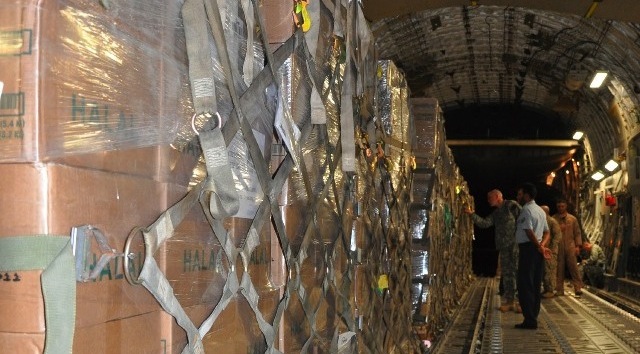As if northern Pakistan hasn’t suffered enough during the rise of the Pakistani Taliban over the last several years, the mass flooding that began late last week provided a new level of devastation. UNICEF estimates that 3.2 million Pakistanis have been displaced or otherwise affected. As many as 1500 people have died. Over 25,000 are stranded and in need of help. And on Sunday, the U.S. Air Force got to work providing some of that aid.
Taking off from Bagram Air Field in Afghanistan, a C-130 from the 455th Expeditionary Air Wing delivered 8,000 halal meals to Islamabad on Sunday. A C-17 from the 385th Expeditionary Air Group stocked with another 44,000 meals arrived soon after. (Full disclosure: the Air Force’s Air Mobility Command is helping me get to Afghanistan, where I’ll check out some of its missions there.) The planes represent the first wave of a $10 million U.S. effort to help with flood relief.
Since Sunday, according to the International Security Assistance Force, the NATO command in Afghanistan, the U.S. has delivered 189,000 halal meals in total. Another 200,000 are scheduled to be delivered within the next 24 hours. That’s a start, but according to the United Nations, 1.8 million people in Pakistan’s Khyber-Pakhtunkhwa Province, the area formerly known as the Northwest Frontier Province and the hardest hit by the flood, are in need of food assistance.
Food aid won’t be all that’s needed. The United Nations is warning of waterborne diseases like diarrhea further afflicting flood victims, so the World Health Organization is dispensing needed medicines. And the U.S. embassy in Pakistan lists some other U.S. assets on hand or soon-to-be-on-hand to assist: four Zodiac inflatable power boats, two water filtration units and 12 pre-fabricated steel bridges to replace washed out overpasses in Peshawar and Kurram.
The Army’s set to help as well. On Wednesday, six Chinook and Blackhawk helicopters from the 101st Airborne Division are scheduled to leave from Ghazi Airbase, carrying about 100 U.S. military personnel. It won’t be the first time U.S. military personnel will have arrived on the ground in Pakistan, despite strong local sensibilities against a U.S. presence in Pakistan.
Whether the U.S. assistance will mitigate extremely negative Pakistani perceptions of the U.S. remains to be seen. A five-year $7.5 billion aid effort announced last year didn’t stop Pakistanis from awarding the U.S. a 17 percent approval rating in a poll Pew released last week. Neither did millions in U.S. aid after the Pakistani earthquake of 2008 that killed at least 200 people. In the meantime, the U.S. military is simply helping out.










